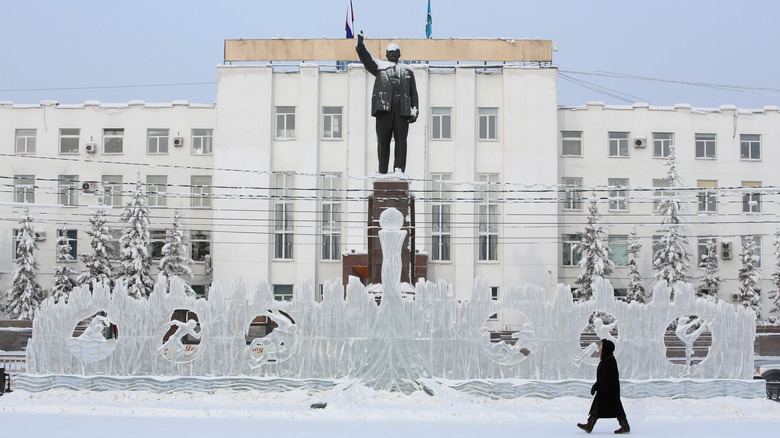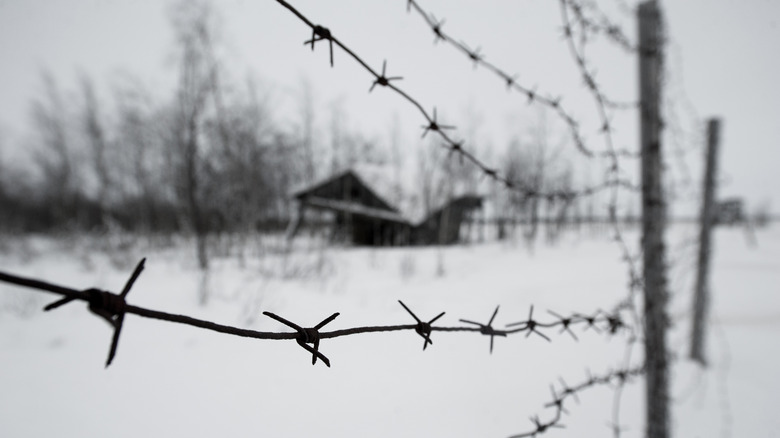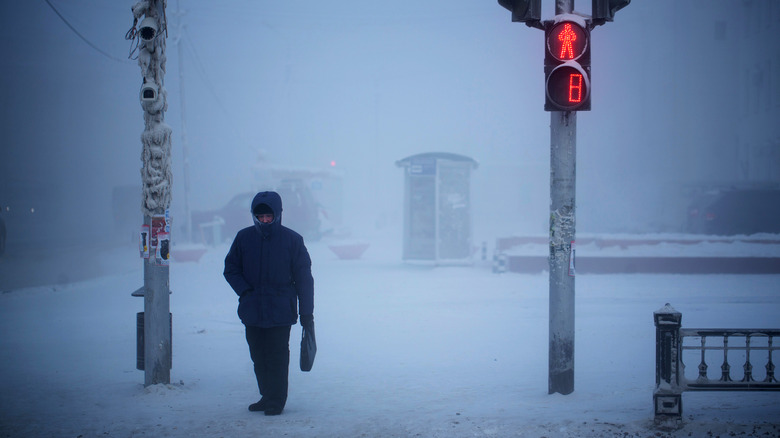How The Coldest City In The World Survives
From this moment on, forget any notion you have of "cold." Not, "It's a bit chilly, so I've got to grab a scarf" cold. Not, "I've got to let my car engine warm up while I shovel out the driveway so I can get to work on time" cold. We're talking, "I will literally die if I stay outside for more than a few minutes no matter how much I bundle up" cold.
Yakutsk, Siberia is the coldest inhabited town on Earth. Located along the Lena River in Eastern Russia, midway between the Arctic Ocean in the north and the Chinese border in the south, the region is subjected to temperatures from -40 Celsius to -50 Celsius (-40 Fahrenheit to -58 Fahrenheit), per the Independent. Its lowest recorded temperature, as Republic World says, was about -64 Celsius (-84 Fahrenheit) back in February, 1987. The entire city is built directly on meters-thick permafrost. Because of this, big machines called thermosyphons ensure that no heat settles underground (per Science Direct).
For months at a time, Yakutsk's roughly 300,000 inhabitants never turn off their cars, as SnowBrains explains. People can't wear metal glasses because the metal will tear off "chunks of cheek." Pipes can't be built underground, as traveler Ruhi Cehet shows on YouTube. In an instant, steaming hot water turns into icy powder. Within minutes, frostbite settles into exposed skin, as Cehet's videographer later discovered in that same video. But somehow, someway, people in Yakutsk have adapted and survived, year after year.
Soviet gulag site for diamond mining
Upon learning about Yakutsk, many folks might rightfully ask, "Why would anyone stay there?" or "How did anyone settle there to begin with?" To the former, we say, "no clue." To the latter we say, "diamonds."
As the Independent explains, the region of Siberia around Yakutsk accounts for 20% of the world's diamond mining, under Russian megacorporate monopoly Alrosa. Modern Yakutsk began as a regional center for the Soviet Union's gulag labor system in the early 20th century, which sent political prisoners off to suffer and die in the Siberian cold by mining precious minerals for the state. The region also happens to be rich in gold. Everything else has to be flown in (although some things, like natural gas and oil, exist underground). That being said, Russia founded Yakutsk's administration way back in 1638 in the pre-central-heating past, as Yakutia Travel says. Long before ethnic Russians arrived, though, indigenous "Lena Yakut" people inhabited the region.
You might think that Yakutsk is the world's northernmost town. But towns in Norway (which contains the world's northernmost city, Longyearbyen), Greenland, Canada, Alaska, and more all sit at higher latitudes. The extreme temperatures in Yakutsk have to do with air flow as it comes down from the Arctic Circle, and Yakutsk's land-locked location far away from warmer ocean water, as Story Maps explains. Building modern Yakutsk required unique techniques, same as its inhabitants have had to adopt unique survival practices.
Built for survival
At worst, Yakutsk really does look like a frozen hell on Earth. A frosted, blustery haze consumes the cityscape during the winter, reducing visibility to meters. It takes layer after layer of thermal clothing just to make it a couple of minutes to the bus before you start to freeze. This means that while cars generally don't work in colder months, people need to leave them running the entire season so the vehicles don't die. Some folks siphon heat outside from their houses through rubber tubes directly into the engines of their cars, under the hood (seen on SnowBrains). Rime encrusts people's eyelashes, and snot-sicles stab one's own lips. Each breath hurts. If you think this is all a dramatic exaggeration, then watch videos of traveler Ruhi Cenet (on YouTube), unreasonably cheerful local Kiun B. (also on YouTube), or nearby countryside dwellers (again, on YouTube).
So how in the world do residents get by? The easy answer is: Don't go outside. Folks do as many indoors activities as possible during winter months, except for quick trips to the grocery store, as Kiun B. further describes on YouTube. Residents often dress to the nines (in big, puffy jackets) to express themselves, as Treehugger explains, and meet up at festivals or inside underground, warmer ice caverns. Folks outside of Yakutsk proper have a harder time, and typically don't have running water. But thankfully, there's an abundance of snow to gather from the ground. Finally, for fun, we've got saunas and ice baths.


